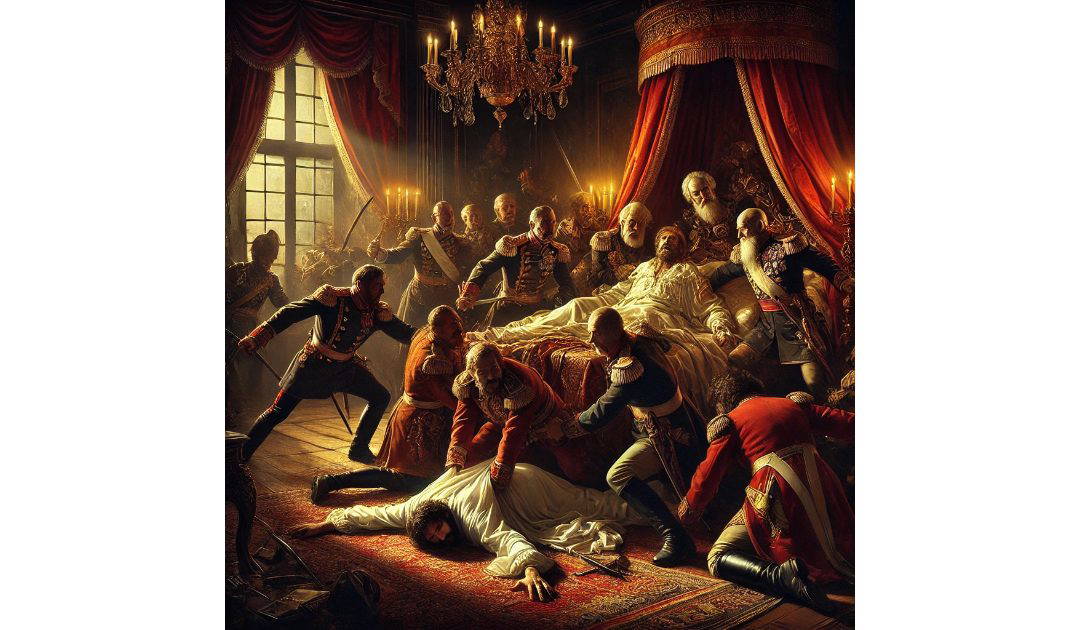On the 23rd of March, 1801, Paul I was struck with a sword, strangled, then trampled to death in his bedroom. Tsar Paul I of Russia, often overshadowed by his more illustrious predecessors and successors, was a monarch whose short and tumultuous reign from 1796 to 1801 left a significant mark on Russian history. His era was fraught with reform, controversy, and ultimately, a violent end that shaped the future trajectory of the Russian Empire.
Born on 1st October 1754, Paul Petrovich was the son of the illustrious Catherine the Great and her husband, Emperor Peter III. From the very beginning, Paul’s life was steeped in palace intrigue and familial discord. His mother, Catherine, seized power in a coup, deposing Peter III. This act of political manoeuvering left an indelible impression on Paul’s psyche, instilling within him a sense of insecurity and suspicion that would later define his reign.
Paul ascended to the throne following Catherine’s death in November 1796. Upon assuming power, he was determined to distance himself from his mother’s policies, which he perceived as too liberal and Westernised. His reign was characterised by attempts to realign Russian society with his vision of orthodoxy, autocracy, and national identity. One of his first acts as Tsar was to introduce a new law of succession, the Pauline Laws, to regulate the hereditary transition of power and prevent the kind of coups that brought his mother to power.
Despite his contentious relationship with Catherine, Paul sought to implement a series of reforms aimed at alleviating some of the burdens on the lower classes, reflecting a complex mix of liberal and conservative ideals. He made efforts to improve the conditions of the serfs, restricting their punishment by landowners and reducing military service obligations. Furthermore, Paul envisioned a modernised Russian army and navy and took steps to implement changes, drawing inspiration from Western military practices while maintaining a uniquely Russian identity.
However, Tsar Paul’s reign was not without controversy. He was perceived as erratic and authoritarian, driven by personal vendettas and whims. His foreign policy vacillated unpredictably; he initially sought to extricate Russia from the coalition against Revolutionary France, only to later form an alliance with Napoleon Bonaparte. Domestically, his reforms were often overshadowed by his impulsive decisions and harsh treatment of the nobility.
Paul’s reign was marked by significant tensions with the Russian aristocracy, who felt alienated by his unpredictable policies and perceived slights against their privilege. His insistence on strict military discipline and bureaucratic efficiency clashed with the established norms of noble privilege, alienating a powerful faction within Russian society.
The culmination of these tensions led to a conspiracy among disgruntled nobles and military officers. On the night of 23rd March, 1801, Paul was assassinated in his bedchamber in Saint Michael’s Castle, St. Petersburg. His death marked the end of a turbulent and brief reign, ushering in the rule of his son, Alexander I, who would earn fame as a reformer and as a foe of Napoleon.
Tsar Paul I of Russia remains a complex and enigmatic figure in Russian history. Though his reign was marred by controversy and ended in tragedy, his efforts at reform and his vision of a strengthened Russian state had lasting impacts. While his policies often stemmed from personal grievances and an autocratic mindset, they also reflected a genuine desire to protect and preserve the Russian state from both internal and external threats.
In historical assessments, Paul’s legacy is often overshadowed by the dramatic political theatre of his time. Yet, his reign provides critical insights into the challenges of leadership and reform in an autocratic state. The lessons from Paul’s turbulent rule resonate even today, reflecting the perpetual tension between tradition and modernisation, authority and reform.
Tsar Paul’s life and rule serve as a reminder of the complexities inherent in governance, and the precarious balance every leader must navigate between enforcing authority and fostering progress. His story is a crucial chapter in understanding the broader narrative of Russian history, marked by its imperial ambition and the struggles of its rulers to wield power effectively.

